Zhaoheng Ni
Interspeech 2025 URGENT Speech Enhancement Challenge
May 29, 2025Abstract:There has been a growing effort to develop universal speech enhancement (SE) to handle inputs with various speech distortions and recording conditions. The URGENT Challenge series aims to foster such universal SE by embracing a broad range of distortion types, increasing data diversity, and incorporating extensive evaluation metrics. This work introduces the Interspeech 2025 URGENT Challenge, the second edition of the series, to explore several aspects that have received limited attention so far: language dependency, universality for more distortion types, data scalability, and the effectiveness of using noisy training data. We received 32 submissions, where the best system uses a discriminative model, while most other competitive ones are hybrid methods. Analysis reveals some key findings: (i) some generative or hybrid approaches are preferred in subjective evaluations over the top discriminative model, and (ii) purely generative SE models can exhibit language dependency.
Adapting Whisper for Code-Switching through Encoding Refining and Language-Aware Decoding
Dec 24, 2024


Abstract:Code-switching (CS) automatic speech recognition (ASR) faces challenges due to the language confusion resulting from accents, auditory similarity, and seamless language switches. Adaptation on the pre-trained multi-lingual model has shown promising performance for CS-ASR. In this paper, we adapt Whisper, which is a large-scale multilingual pre-trained speech recognition model, to CS from both encoder and decoder parts. First, we propose an encoder refiner to enhance the encoder's capacity of intra-sentence swithching. Second, we propose using two sets of language-aware adapters with different language prompt embeddings to achieve language-specific decoding information in each decoder layer. Then, a fusion module is added to fuse the language-aware decoding. The experimental results using the SEAME dataset show that, compared with the baseline model, the proposed approach achieves a relative MER reduction of 4.1% and 7.2% on the dev_man and dev_sge test sets, respectively, surpassing state-of-the-art methods. Through experiments, we found that the proposed method significantly improves the performance on non-native language in CS speech, indicating that our approach enables Whisper to better distinguish between the two languages.
Serialized Speech Information Guidance with Overlapped Encoding Separation for Multi-Speaker Automatic Speech Recognition
Sep 01, 2024



Abstract:Serialized output training (SOT) attracts increasing attention due to its convenience and flexibility for multi-speaker automatic speech recognition (ASR). However, it is not easy to train with attention loss only. In this paper, we propose the overlapped encoding separation (EncSep) to fully utilize the benefits of the connectionist temporal classification (CTC) and attention hybrid loss. This additional separator is inserted after the encoder to extract the multi-speaker information with CTC losses. Furthermore, we propose the serialized speech information guidance SOT (GEncSep) to further utilize the separated encodings. The separated streams are concatenated to provide single-speaker information to guide attention during decoding. The experimental results on LibriMix show that the single-speaker encoding can be separated from the overlapped encoding. The CTC loss helps to improve the encoder representation under complex scenarios. GEncSep further improved performance.
High Fidelity Text-Guided Music Generation and Editing via Single-Stage Flow Matching
Jul 04, 2024



Abstract:We introduce a simple and efficient text-controllable high-fidelity music generation and editing model. It operates on sequences of continuous latent representations from a low frame rate 48 kHz stereo variational auto encoder codec that eliminates the information loss drawback of discrete representations. Based on a diffusion transformer architecture trained on a flow-matching objective the model can generate and edit diverse high quality stereo samples of variable duration, with simple text descriptions. We also explore a new regularized latent inversion method for zero-shot test-time text-guided editing and demonstrate its superior performance over naive denoising diffusion implicit model (DDIM) inversion for variety of music editing prompts. Evaluations are conducted on both objective and subjective metrics and demonstrate that the proposed model is not only competitive to the evaluated baselines on a standard text-to-music benchmark - quality and efficiency-wise - but also outperforms previous state of the art for music editing when combined with our proposed latent inversion. Samples are available at https://melodyflow.github.io.
URGENT Challenge: Universality, Robustness, and Generalizability For Speech Enhancement
Jun 07, 2024



Abstract:The last decade has witnessed significant advancements in deep learning-based speech enhancement (SE). However, most existing SE research has limitations on the coverage of SE sub-tasks, data diversity and amount, and evaluation metrics. To fill this gap and promote research toward universal SE, we establish a new SE challenge, named URGENT, to focus on the universality, robustness, and generalizability of SE. We aim to extend the SE definition to cover different sub-tasks to explore the limits of SE models, starting from denoising, dereverberation, bandwidth extension, and declipping. A novel framework is proposed to unify all these sub-tasks in a single model, allowing the use of all existing SE approaches. We collected public speech and noise data from different domains to construct diverse evaluation data. Finally, we discuss the insights gained from our preliminary baseline experiments based on both generative and discriminative SE methods with 12 curated metrics.
An Empirical Study on the Impact of Positional Encoding in Transformer-based Monaural Speech Enhancement
Jan 18, 2024Abstract:Transformer architecture has enabled recent progress in speech enhancement. Since Transformers are position-agostic, positional encoding is the de facto standard component used to enable Transformers to distinguish the order of elements in a sequence. However, it remains unclear how positional encoding exactly impacts speech enhancement based on Transformer architectures. In this paper, we perform a comprehensive empirical study evaluating five positional encoding methods, i.e., Sinusoidal and learned absolute position embedding (APE), T5-RPE, KERPLE, as well as the Transformer without positional encoding (No-Pos), across both causal and noncausal configurations. We conduct extensive speech enhancement experiments, involving spectral mapping and masking methods. Our findings establish that positional encoding is not quite helpful for the models in a causal configuration, which indicates that causal attention may implicitly incorporate position information. In a noncausal configuration, the models significantly benefit from the use of positional encoding. In addition, we find that among the four position embeddings, relative position embeddings outperform APEs.
On The Open Prompt Challenge In Conditional Audio Generation
Nov 01, 2023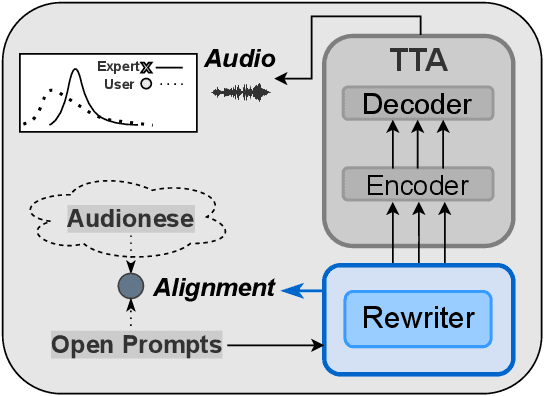
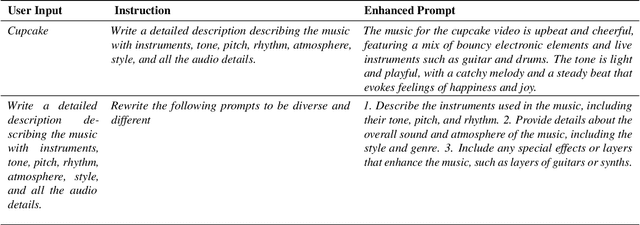
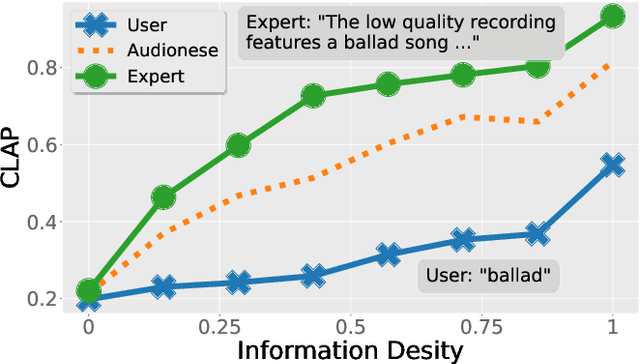

Abstract:Text-to-audio generation (TTA) produces audio from a text description, learning from pairs of audio samples and hand-annotated text. However, commercializing audio generation is challenging as user-input prompts are often under-specified when compared to text descriptions used to train TTA models. In this work, we treat TTA models as a ``blackbox'' and address the user prompt challenge with two key insights: (1) User prompts are generally under-specified, leading to a large alignment gap between user prompts and training prompts. (2) There is a distribution of audio descriptions for which TTA models are better at generating higher quality audio, which we refer to as ``audionese''. To this end, we rewrite prompts with instruction-tuned models and propose utilizing text-audio alignment as feedback signals via margin ranking learning for audio improvements. On both objective and subjective human evaluations, we observed marked improvements in both text-audio alignment and music audio quality.
TorchAudio 2.1: Advancing speech recognition, self-supervised learning, and audio processing components for PyTorch
Oct 27, 2023
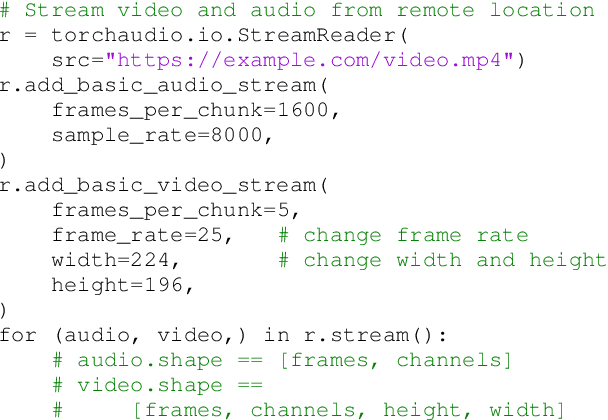

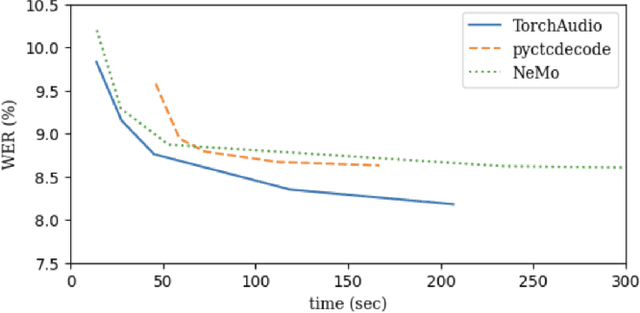
Abstract:TorchAudio is an open-source audio and speech processing library built for PyTorch. It aims to accelerate the research and development of audio and speech technologies by providing well-designed, easy-to-use, and performant PyTorch components. Its contributors routinely engage with users to understand their needs and fulfill them by developing impactful features. Here, we survey TorchAudio's development principles and contents and highlight key features we include in its latest version (2.1): self-supervised learning pre-trained pipelines and training recipes, high-performance CTC decoders, speech recognition models and training recipes, advanced media I/O capabilities, and tools for performing forced alignment, multi-channel speech enhancement, and reference-less speech assessment. For a selection of these features, through empirical studies, we demonstrate their efficacy and show that they achieve competitive or state-of-the-art performance.
FoleyGen: Visually-Guided Audio Generation
Sep 19, 2023Abstract:Recent advancements in audio generation have been spurred by the evolution of large-scale deep learning models and expansive datasets. However, the task of video-to-audio (V2A) generation continues to be a challenge, principally because of the intricate relationship between the high-dimensional visual and auditory data, and the challenges associated with temporal synchronization. In this study, we introduce FoleyGen, an open-domain V2A generation system built on a language modeling paradigm. FoleyGen leverages an off-the-shelf neural audio codec for bidirectional conversion between waveforms and discrete tokens. The generation of audio tokens is facilitated by a single Transformer model, which is conditioned on visual features extracted from a visual encoder. A prevalent problem in V2A generation is the misalignment of generated audio with the visible actions in the video. To address this, we explore three novel visual attention mechanisms. We further undertake an exhaustive evaluation of multiple visual encoders, each pretrained on either single-modal or multi-modal tasks. The experimental results on VGGSound dataset show that our proposed FoleyGen outperforms previous systems across all objective metrics and human evaluations.
Exploring Speech Enhancement for Low-resource Speech Synthesis
Sep 19, 2023



Abstract:High-quality and intelligible speech is essential to text-to-speech (TTS) model training, however, obtaining high-quality data for low-resource languages is challenging and expensive. Applying speech enhancement on Automatic Speech Recognition (ASR) corpus mitigates the issue by augmenting the training data, while how the nonlinear speech distortion brought by speech enhancement models affects TTS training still needs to be investigated. In this paper, we train a TF-GridNet speech enhancement model and apply it to low-resource datasets that were collected for the ASR task, then train a discrete unit based TTS model on the enhanced speech. We use Arabic datasets as an example and show that the proposed pipeline significantly improves the low-resource TTS system compared with other baseline methods in terms of ASR WER metric. We also run empirical analysis on the correlation between speech enhancement and TTS performances.
 Add to Chrome
Add to Chrome Add to Firefox
Add to Firefox Add to Edge
Add to Edge